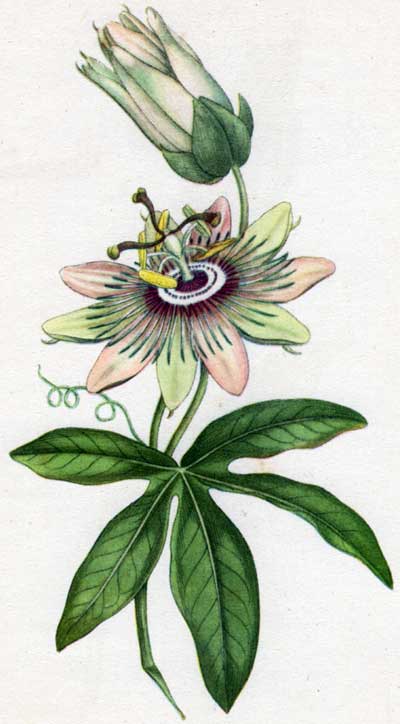 Also Known As:
Also Known As:
Pasiflora, Passiflorae Herba.
Scientific Name:
Passiflora incarnata.
Family: Passifloraceae.
People Use This For:
Passionflower is used for insomnia, gastrointestinal upset related to anxiety or nervousness, generalized anxiety disorder. Passionflower is also used orally for neuralgia, generalized seizures, spasmodic asthma, menopausal symptoms, attention deficit-hyperactivity disorder , nervousness and excitability, palpitations, heart rhythm abnormalities, high blood pressure, fibromyalgia, and pain relief.
In foods and beverages, passionflower extract is used as a flavoring.
Safety:
No concerns regarding safety when used orally in amounts commonly found in foods. Passionflower has Generally Recognized As Safe status (GRAS) for use in foods in the US.46
No concerns regarding safety when used orally and appropriately, short-term for medicinal purposes. There is evidence that passionflower liquid extracts can be safely used for up to one month.47,48,49
Pregnancy and Lactation: Refer to a Medical Herbalist.
Effectiveness:
POSSIBLY EFFECTIVE
Adjustment disorder with anxious mood. A specific combination product (Euphytose, EUP) that includes passionflower seems to decrease some symptoms of adjustment disorder with anxious mood. However, it's not known which ingredient or ingredients are responsible for the beneficial effects. Other herbs in the product are crataegus, ballota, and valerian, which have mild sedative effects, and cola and paullinia with stimulant properties.50
Anxiety. There is some evidence that passionflower can reduce symptoms of anxiety.51 Some research shows that a liquid extract 45 drops daily is comparable to oxazepam (Serax) 30 mg for treating symptoms of GAD in some patients.49 Additional research shows that a different passionflower extract 90 mg/day reduces symptoms of non-specific anxiety comparable to mexazolam.52
Opiate withdrawal. Passionflower liquid extract 60 drops, in combination with clonidine 0.8 mg daily, seems to be significantly better than clonidine alone when used for reducing symptoms such as anxiety, irritability, insomnia, and agitation. However, the combination is no better than clonidine alone for physical symptoms such as tremor and nausea.48
Mechanism of Action:
The applicable parts of passionflower are the above ground parts. Passionflower contains several active constituents including a range of flavonoids. The harman (harmala) alkaloids identified in passionflower include harmine, harmaline, harmalol, harman, and harmin.53,54,55 Other constituents include maltol and ethyl maltol.55
Passionflower has sedative, hypnotic, anxiolytic, analgesic, and antispasmodic effects.53,54
Some evidence suggests the passionflower constituent apigenin binds to central benzodiazepine receptors,56 possibly causing anxiolytic effects without impairing memory or motor skills.56
Other evidence suggests passionflower extracts might reduce amphetamine-induced hypermotility, aggressiveness, and restlessness; and raise the pain threshold.57,58,59
Adverse Reactions:
Passionflower is generally well tolerated with few side effects.R2pp.329Uncommonly Passionflower may cause dizziness, confusion, sedation, and unsteady gait.49,52,51 There are 2 case reports of possible severe side effects with Passiflora in the literature.
Interactions with Herbs & Supplements:
Herbs and Supplements with Sedative Properties: May enhance the effectiveness.
Interactions with Drugs:
CNS Depressants: May enhance the effectiveness. Refer to a Medical Herbalist or other Medical Adviser.
Interactions with Foods:
None known.
Interactions with Lab Tests:
None known.
Dosage/Administration:
Dr Clare’s Blends: Dose 455mgs per day. 1.5mls 1:3 Tincture.
Oral: The average amount of passionflower is 4-8 grams per day.
References: monograph: PASSIONFLOWER
46. FDA. Center for Food Safety and Applied Nutrition, Office of Premarket Approval, EAFUS: A food additive database. Available at: vm.cfsan.fda.gov/~dms/eafus.html.
47. McGuffin M, Hobbs C, Upton R, Goldberg A, eds. American Herbal Products Association's Botanical Safety Handbook. Boca Raton, FL: CRC Press, LLC 1997.
48 Akhondzadeh S, Kashani L, Mobaseri M, et al. Passionflower in the treatment of opiates withdrawal: a double-blind randomized controlled trial. J Clin Pharm Ther 2001;25:369-73.
49. Akhondzadeh S, Naghavi HR, Shayeganpour A, et al. Passionflower in the treatment of generalized anxiety: a pilot double-blind randomized controlled trial with oxazepam. J Clin Pharm Ther 2001;26:363-7.
50. Bourin M, Bougerol T, Guitton B, Broutin E. A combination of plant extracts in the treatment of outpatients with adjustment disorder with anxious mood: controlled study vs placebo. Fundam Clin Pharmacol 1997;11:127-32.
51. Miyasaka LS, Atallah AN, Soares BG. Passiflora for anxiety disorder. Cochrane Database Syst Rev 2007;(1):CD004518.
52. Mori A, Hasegawa K, Murasaki M, et al. Clinical evaluation of Passiflamin (passiflora extract) on neurosis - multicenter double blind study in comparison with mexazolam. Rinsho Hyoka Clinical Evaluation) 1993;21:383-440.
53. Dhawan K, Kumar S, Sharma A. Anxiolytic activity of aerial and underground parts of Passiflora incarnata. Fitoterapia 2001;72:922-6.
54. Dhawan K, Kumar S, Sharma A. Anti-anxiety studies on extracts of Passiflora incarnata Linneaus. J Ethnopharmacol 2001;78:165-70.
55. Aoyagi N, Kimura R, Murata T. Studies on passiflora incarnata dry extract. I. Isolation of maltol and pharmacological action of maltol and ethyl maltol. Chem Pharm Bull 1974;22:1008-13.
56. Salgueiro JB, Ardenghi P, Dias M, et al. Anxiolytic natural and synthetic flavonoid ligands of the central benzodiazepine receptor have no effect on memory tasks in rats. Pharmacol Biochem Behav 1997;58:887-91.
57. Monographs on the medicinal uses of plant drugs. Exeter, UK: European Scientific Co-op Phytother, 1997.
58. Newall CA, Anderson LA, Philpson JD. Herbal Medicine: A Guide for Healthcare Professionals. London, UK: The Pharmaceutical Press, 1996.
59. Leung AY, Foster S. Encyclopedia of Common Natural Ingredients Used in Food, Drugs and Cosmetics. 2nd ed. New York, NY: John Wiley & Sons, 1996.